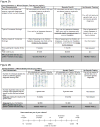Return of incidental findings in genomic medicine: measuring what patients value--development of an instrument to measure preferences for information from next-generation testing (IMPRINT)
- PMID: 23722871
- PMCID: PMC3823641
- DOI: 10.1038/gim.2013.63
Return of incidental findings in genomic medicine: measuring what patients value--development of an instrument to measure preferences for information from next-generation testing (IMPRINT)
Abstract
Purpose: Little is known about the factors that influence patients' preferences for the return of incidental findings from genome sequencing. This study identified attributes of incidental findings that were important to patients and developed a discrete-choice experiment instrument to quantify patient preferences.
Methods: An initial set of key attributes and attribute levels was developed from a literature review and in consultation with experts. The attributes' salience and communication were refined using focus group methodology (n = 12) and cognitive interviews (n = 6) with patients who had received conventional genetic testing for familial colorectal cancer or polyposis syndromes. The attributes and levels used in the hypothetical choices presented to participants were identified using validated experimental design techniques.
Results: The final discrete-choice experiment instrument incorporates the following attributes and levels: lifetime risk of disease (5, 40, 70%); disease treatability (medical, lifestyle, none); disease severity (mild, moderate, severe); carrier status (yes, no); drug response likelihood (high, moderate, none); and test cost ($250, $425, $1,000, $1,900).
Conclusion: Patient preferences for incidental genomic findings are likely influenced by a complex set of diverse attributes. Quantification of patient preferences can inform patient-provider communication by highlighting the attributes of incidental findings that matter most to patients and warrant further discussion.
Figures



References
-
- Knoppers BM, Joly Y, Simard J, Durocher F. The emergence of an ethical duty to disclose genetic research results: international perspectives. Eur J Hum Genet. 2006 Nov;14(11):1170–1178. - PubMed
-
- Grosse SD, Khoury MJ. What is the clinical utility of genetic testing? Genet Med. 2006 Jul;8(7):448–450. - PubMed
-
- Berwick DM, Weinstein MC. What do patients value? Willingness to pay for ultrasound in normal pregnancy. Med Care. 1985 Jul;23(7):881–893. - PubMed
Publication types
MeSH terms
Grants and funding
LinkOut - more resources
Full Text Sources
Other Literature Sources
Medical

